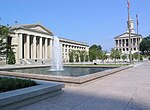Tennessee Performing Arts Center
1980 establishments in TennesseeBuildings and structures in Nashville, TennesseePerforming arts centers in TennesseeTourist attractions in Nashville, TennesseeUse American English from October 2016 ... and 2 more
Use mdy dates from October 2016Vague or ambiguous time from October 2016

The Tennessee Performing Arts Center (TPAC) is located in the James K. Polk Cultural Center at 505 Deaderick Street in downtown Nashville, Tennessee. It occupies a city block between 5th and 6th Avenues North and Deaderick and Union Streets. The cultural center adjoins the 18-story James K. Polk State Office Building.
Excerpt from the Wikipedia article Tennessee Performing Arts Center (License: CC BY-SA 3.0, Authors, Images).Tennessee Performing Arts Center
Union Street, Nashville-Davidson
Geographical coordinates (GPS) Address Nearby Places Show on map
Geographical coordinates (GPS)
| Latitude | Longitude |
|---|---|
| N 36.1649 ° | E -86.7817 ° |
Address
Union Street
37201 Nashville-Davidson
Tennessee, United States
Open on Google Maps









